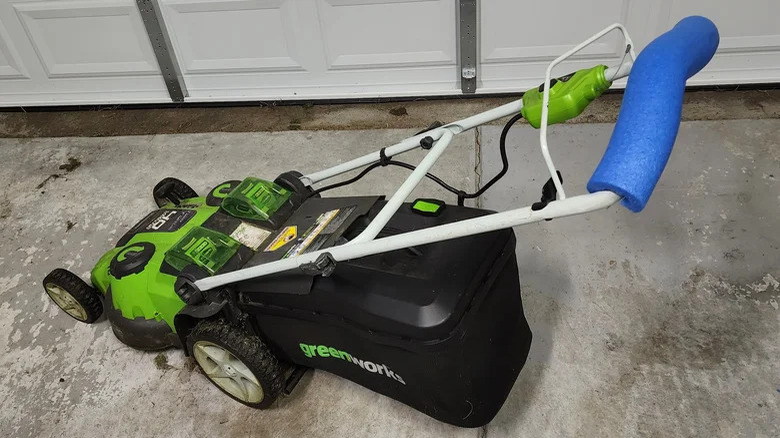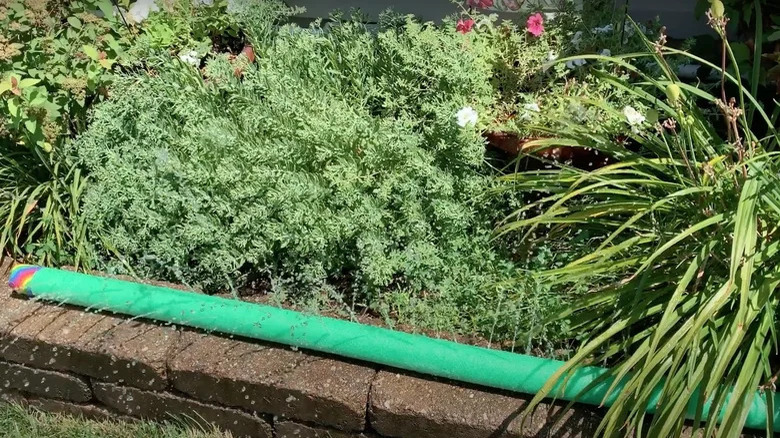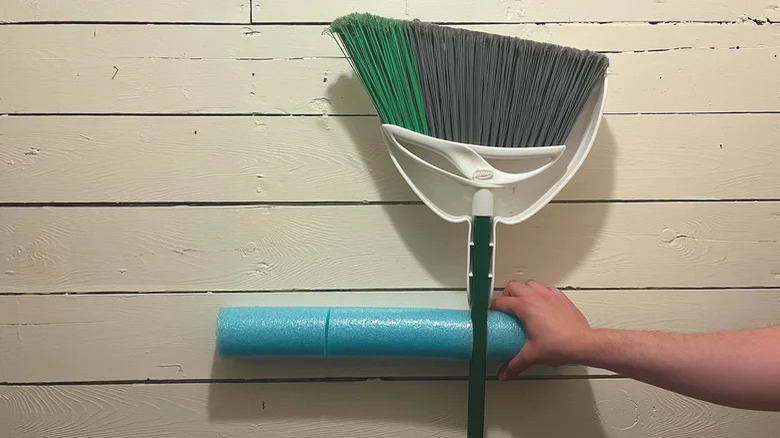Brilliant Pool Noodle Hacks For Your Home & Garden Tools
We may receive a commission on purchases made from links.
TikTok, and other social media apps, are full of brilliant homeowner hacks that turn the most unassuming items into genius DIY solutions. Pool noodles are one such item, and they are no longer solely considered swimming toys. Instead, internet users have blown these flexible floaties out of the water, wowing users with their many uses beyond summer fun. With just a few adjustments, anyone can incorporate these foam tubes into many roles throughout their home and garden.
So, here are some brilliant pool noodle DIYs for indoor and outdoor tools. In just a few minutes, you can transform tools to be more comfortable, functional, and organized. The best part about these home DIYs is that the main ingredient is just a pool noodle, which costs around a dollar at many major retailers. Many households already have the other necessary supplies and tools on hand, making these projects budget-friendly and easy to implement.
Create an ergonomic cushion for outdoor tools with wooden handles
Pool noodles can make tasks like raking easier by creating a softer grip. Make outdoor tools more ergonomic by slipping a pool noodle over the wooden portion. If you have trouble sliding the pool noodle over the wood, lubricate the inside with Original WD-40 Formula Multi-Use Product. The standard pool noodle hole is about one inch in diameter. Given many tool handles are around the same size, this hack should work on various items, including rakes, shovels, trimmers, wheel barrels, and more.
DIY a lawn mower cover to protect your hands and reduce vibrations
Wooden and basic tools aren't the only outdoor equipment that benefits from a pool noodle upgrade. You can even make mowing easier with a pool noodle handle guard for extra cushion. The foam adds a layer of insulation, which absorbs the shaking caused by the running mower engine. The muffled vibrations make it easier to mow for longer, because the insulation minimizes the minor but repetitive injuries that constant mechanical tremoring can cause.
Transform a garden hose into a sprinkler to water gardens and lawns
Do you have large garden beds that need constant watering? Instead of splurging on an expensive irrigation system, poke holes in a pool noodle and slide it over a garden hose to make a water sprayer. If you need to cover more square footage, duct tape additional pool noodles to the end of the first to extend its reach. Keep in mind that the fewer holes you poke, the further down the line the water can go. This will allow you to water your plants slowly, with very little effort on your part.
Organize and store garden tools standing up
Create a pool noodle wall rack to house your tools, corralling them in a spot that is safe and secure. Many garden tools, such as pitchforks and rakes, have sharp blades or pointy ends. Leaving them lying around a garage, shed, or yard can lead to dangerous but easily avoidable accidents or them getting lost. Instead, attach the pool noodles to any fence or wall to keep your tools in a convenient place. This pool noodle hack can also work to store cleaning supplies inside the house, such as brooms, mops, and squeegees.
Make a protector for sharp home and garden tools
Tools with fine-toothed tines and prongs shouldn't be left exposed. Just as pool noodles cushion their rough handles, they can also sheath the pointy tips of your metal rakes. You can simply slide the pool noodle over the tool as a cover. Or, if you need to push spills out of your garage or remove standing water from your patio, you can add zip ties to secure the pool noodle and create a makeshift squeegee.
Protect cords on electric garden tools
Many automatic garden tools hook up to outdoor outlets via a long electric cord. This cutting equipment, like chainsaws, hedge trimmers, lawn edgers, and pole saws, can come dangerously close to those power cords, especially when operated by an amateur. Pick a pool noodle, or several pool noodles, long enough to cover the bare power cord. This is a simple way to protect your device and your safety while operating these power tools, and it can be easily removed for storage.
Stop garden hoses from kinking at the spigot
There are two ways to prevent garden hose kinks with pool noodles, especially at the spigot. One method requires a cut pool noodle and two zip-ties to secure it just below the spigot. This will keep it from kinking as you use it. However, you can also do this hack without any additional supplies. For the latter method, detach the hose, feed it through the pool noodle, and reattach it to the spigot. The pool noodle holds the top of the hose in a straight line, preventing it from bending and blocking water flow.
Keep ladders from damaging home exteriors with protective cushions
Homeowners must be able to reach the roof to clean gutters and clear away fallen debris. However, leaning a metal ladder against a house can scratch the gutters, roofing, or siding. If you add two sections of pool noodle on the backside of the upper legs, it can mitigate potential damage. Remember, the pool noodles could compromise the steadiness if it's not set up securely at around a 75-degree angle. So, make sure you give the ladder a few test shakes before climbing it to ensure it's safely balanced against the building.
Make it easier to maneuver a pool skimmer net by buffering water
Fighting the water tension while operating a pool net that's several feet long is a tedious chore. However, you can add a pool noodle to help the tool float and glide across the water. One TikTok user recommended putting the foam by the handle, while another placed it in the very front. In either case, the noodle makes the skimmer operable with just one hand. If you have trouble keeping the pool noodle attached, you can use a few zip-tie fasteners.
Efficiently funnel sink water into oversized mop buckets
Filling mop buckets is an arduous task if you're doing it little-by-little with small scoops of water. Fortunately, many sink faucets have a slim cylindrical shape that fits inside a pool noodle. Direct the other end of the foam tube into the bucket, creating a direct tunnel for running water. It may be tempting to leave the noodle unattended, but you should always keep a hand on the foam. If it falls out of place or fills the bucket too quickly, the resulting spill won't be fun to clean up.
Separate and prevent electrical cords from tangling
Every modern home is filled with various electrical cords for a horde of appliances and devices. If you have more cables, cords, and wires than you can count, try tucking one to three of them into a single pool noodle before tossing them into storage bins. No tangles means your cords aren't getting knotted and bent, which frays their inner wires. So, this prevents them from getting lost in a frustrating mess and can extend their overall lifespan.
Craft an organized screwdriver holder with foam and a wood block
Screwdrivers come in different sizes and types, and many people own multiple kinds and duplicates. Keep your screwdriver collection in order by sticking the pointy ends through a foam noodle. You can create the exact size you need according to the number of screwdrivers that you have to organize. Then, attach the DIY screwdriver holder to a wood block base, and set it somewhere easily accessible for home projects.
Connect a pool noodle to a vacuum to reach high and narrow places
It's impossible to reach every nook and cranny in a room without a vacuum attachment. However, these attachments can be pricey, making this hack with a pool noodle a budget-friendly alternative. The center of a pool noodle fits perfectly over your vacuum hose, extending it from three to five feet, depending on the length of the pool toy. Plus, since foam is lightweight, most people can lift this TikTok-inspired pool noodle vacuum attachment to remove cobwebs from doorframes, windowpanes, and ceiling corners.



